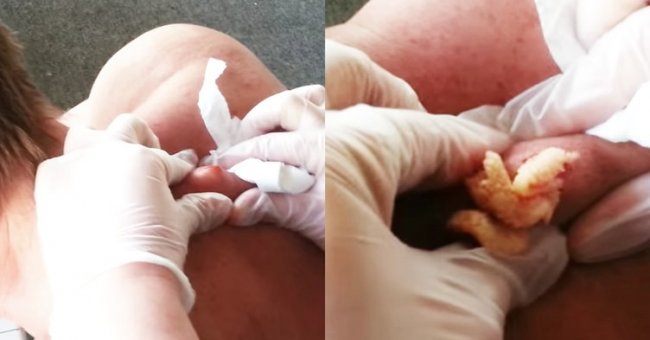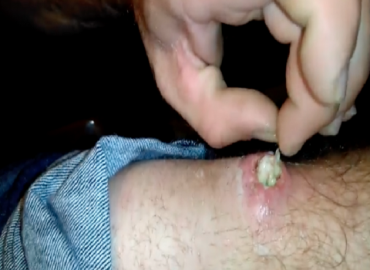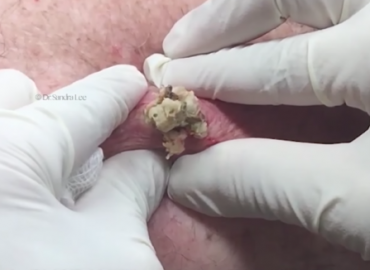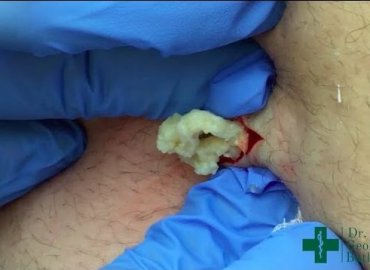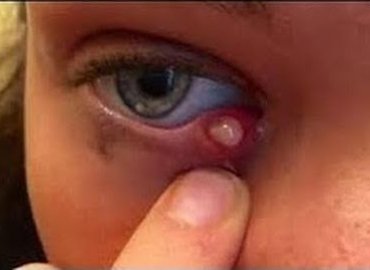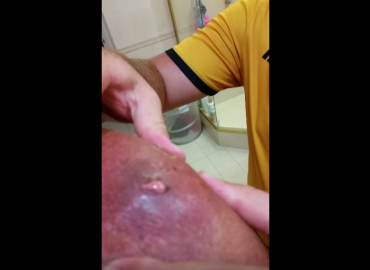Distinguish between a sebaceous cyst and epidermoid cyst. An epidermoid cyst is more common than a sebaceous cyst. Each will have slightly different symptoms and will be treated just a little differently. Therefore, it is important that the cyst you have on your skin is diagnosed appropriately for effective treatment.
Both types of cysts are flesh-colored or white-yellow and have a smooth surface.
Epidermoid cysts are more common. These are slow growing and often painless. They don’t usually require treatment, unless they are causing pain or become infected.
Pilar cysts are composed primarily of keratin (the protein that makes up hair and nails) and form from the outer hair root sheath, typically on the head. A pilar cyst is often thought to be another term for a sebaceous cysts, but they are in fact different.
Sebaceous cysts are commonly found in the hair follicles on the head. They form inside the glands that secrete sebum, an oily substance that coats the hair. When these normal secretions are trapped, they develop into a pouch containing a cheese-like substance. They are commonly found in areas near the neck, upper back, and on the scalp. Sebaceous cysts are often confused with pilar or epidermoid cysts.
Distinguish between cysts in the breast and tumors. Cysts can be in one or both breasts. Without a mammogram or needle biopsy it is almost impossible to distinguish between the two different types of lumps in the breast. Symptoms of a breast cyst will include:
Smooth, easily movable lump with distinct edges
Pain or tenderness over the lump
Size and tenderness will increase just before your period starts
Size and tenderness will decrease when your period ends
Understand cystic acne. Acne is a general term that describes a variety of different types of pimples, blackheads, pustules, whiteheads and cysts. Cystic acne are nodules that are red, raised, often 2–4 mm in size and nodular and are the most severe form of acne. The infection in a cystic acne is deeper than that in other pustules or whiteheads. Cystic acne is painful.
Identify a ganglion cyst. These are the most common types of lumps found on the hand and wrist. They are not cancerous and often harmless. Filled with fluid, they can quickly appear, disappear or change in size. They do not require treatment unless they interfere with function or are unacceptable in appearance.
Determine if pain is from a pilonidal cyst. In this condition there is a cyst, abscess or dimple that forms in the crease between the buttocks that runs from the lower end of the spine to the anus. It can be caused from wearing tight clothing, excess body hair, sitting for long periods of time or obesity. Symptoms can include pus from the area, tenderness over the cyst, or the skin may be warm, tender or swollen near the tailbone. Or there may not be any symptoms beside a pit or dimple at the base of the spine.
Distinguish a Bartholin gland cyst. These glands are located on either side of the vaginal opening to lubricate the vagina. When the gland becomes obstructed, a relatively painless swelling forms called a Bartholin’s cyst. If the cyst is not infected you may not notice it. An infection can occur in a matter of days causing tenderness, fever, discomfort walking, pain with intercourse, and a tender, painful lump near the vaginal opening.
See a doctor for swelling in the testicles. All testicular swelling must be diagnosed by a physician to determine the differences between a cyst, cancerous growth, hydrocele or infection in the testicles. A testicular cysts, also called a spermatocele or epididymal cyst, is typically a painless, fluid-filled, noncancerous sac in the scrotum above the testicles.
This year is already proving to be a good one—for fans of pimple popping and cyst extracting videos, at least. The YouTube channel ViralHog just uploaded a video called “30 Year Old Cyst Explosion,” which, well, shows someone popping a massive 30-year-old cyst. Needless to say, this video is not for the faint of heart. But it is perfect for people who can’t take their eyes off those disgustingly mesmerizing pimple popping videos that keep taking the internet by storm.
ViralHog’s cyst popping video is only 36 seconds long, but it feels like it lasts a lifetime. The clip opens on a shirtless person hunched over with a huge cyst on their back. Two rubber glove-covered hands grip the cyst and begin massaging out all the gunk that’s inside it. Everyone around can be heard squealing and screaming, shocked by the “disgusting” act that they’re witnessing. “This is f**king gross,” one person exclaims. “It looks like cheese,” another yells. Before too long, the cyst has been popped, and the rubber glove hands swoop in to clean up the mess they’ve left behind. The whole thing wasn’t pretty, but it was fairly gratifying nonetheless.
Let’s not beat around the bush here: This video is truly gross. But—as with any good pimple popping video—there’s something uniquely satisfying about watching all that gunk squirt out, knowing that the culpable zit or cyst has been deflated. But remember: There is a right way to do a pimple or cyst extraction, and popping is not it. Trying to get rid of blackheads, acne, or cysts without the help of a professional is never advisable, so you should probably hit up your dermatologist if you find yourself with a cyst of this caliber. (Still, there’s no harm in watching—right?)

